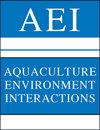黄海北部陆架的快速水温变化
IF 2.5
2区 农林科学
Q2 FISHERIES
引用次数: 1
摘要
夏季,黄海北部陆架底部水温存在较大的空间变异性。这种变化与沿大陆架的热锋有关。半日潮和两周潮的振荡流横向输送水团,造成固定位置的底水温振荡,有时振幅很大。正如本研究所证明的那样,温度变化会对海底养殖的扇贝造成损害。特别是在夏末,在獐子岛附近的扇贝海养殖区,这种振荡较为明显。我们根据当前模式的结果构建了一个汇总温度变率的空间指数,以确定夏季期间的时间变率在空间上的变化。这些信息可用于选择有利的牧区和设计对水产养殖候选物种的实验室应激试验。本文章由计算机程序翻译,如有差异,请以英文原文为准。
Rapid water temperature variations at the northern shelf of the Yellow Sea
During summer, there is great spatial variability in bottom water temperature on the northern shelf of the Yellow Sea. This variability is associated with a thermal front along the shelf. Oscillatory currents from semidiurnal and fortnightly period tides transport water masses laterally, resulting in oscillations of bottom water temperature at fixed positions, sometimes with large amplitudes. Temperature variations, as demonstrated in the present work, can cause damage to bottom-cultured scallops. In particular, in the scallop sea ranching area near Zhangzidao Island, such oscillations are evident in late summer. We constructed a spatial index of aggregated temperature variability from current model results identifying how temporal variability during the summer period varies in space. This information can be useful both in selecting favorable ranching areas and designing laboratory stress experiments on aquaculture candidate species.
求助全文
通过发布文献求助,成功后即可免费获取论文全文。
去求助
来源期刊

Aquaculture Environment Interactions
FISHERIES-MARINE & FRESHWATER BIOLOGY
CiteScore
4.90
自引率
13.60%
发文量
15
审稿时长
>12 weeks
期刊介绍:
AEI presents rigorously refereed and carefully selected Research Articles, Reviews and Notes, as well as Comments/Reply Comments (for details see MEPS 228:1), Theme Sections and Opinion Pieces. For details consult the Guidelines for Authors. Papers may be concerned with interactions between aquaculture and the environment from local to ecosystem scales, at all levels of organisation and investigation. Areas covered include:
-Pollution and nutrient inputs; bio-accumulation and impacts of chemical compounds used in aquaculture.
-Effects on benthic and pelagic assemblages or processes that are related to aquaculture activities.
-Interactions of wild fauna (invertebrates, fishes, birds, mammals) with aquaculture activities; genetic impacts on wild populations.
-Parasite and pathogen interactions between farmed and wild stocks.
-Comparisons of the environmental effects of traditional and organic aquaculture.
-Introductions of alien species; escape and intentional releases (seeding) of cultured organisms into the wild.
-Effects of capture-based aquaculture (ranching).
-Interactions of aquaculture installations with biofouling organisms and consequences of biofouling control measures.
-Integrated multi-trophic aquaculture; comparisons of re-circulation and ‘open’ systems.
-Effects of climate change and environmental variability on aquaculture activities.
-Modelling of aquaculture–environment interactions; assessment of carrying capacity.
-Interactions between aquaculture and other industries (e.g. tourism, fisheries, transport).
-Policy and practice of aquaculture regulation directed towards environmental management; site selection, spatial planning, Integrated Coastal Zone Management, and eco-ethics.
 求助内容:
求助内容: 应助结果提醒方式:
应助结果提醒方式:


